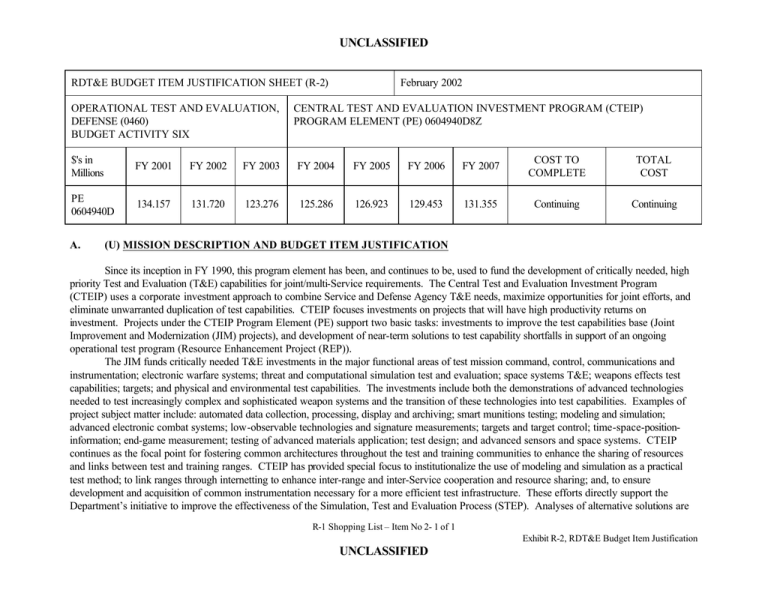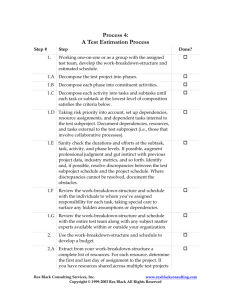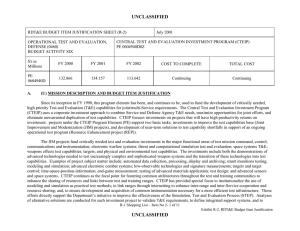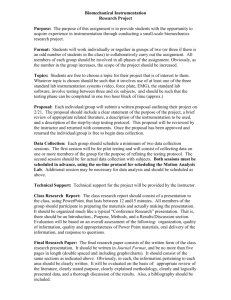UNCLASSIFIED
advertisement

UNCLASSIFIED RDT&E BUDGET ITEM JUSTIFICATION SHEET (R-2) OPERATIONAL TEST AND EVALUATION, DEFENSE (0460) BUDGET ACTIVITY SIX February 2002 CENTRAL TEST AND EVALUATION INVESTMENT PROGRAM (CTEIP) PROGRAM ELEMENT (PE) 0604940D8Z $'s in Millions FY 2001 FY 2002 FY 2003 FY 2004 FY 2005 FY 2006 FY 2007 COST TO COMPLETE TOTAL COST PE 0604940D 134.157 131.720 123.276 125.286 126.923 129.453 131.355 Continuing Continuing A. (U) MISSION DESCRIPTION AND BUDGET ITEM JUSTIFICATION Since its inception in FY 1990, this program element has been, and continues to be, used to fund the development of critically needed, high priority Test and Evaluation (T&E) capabilities for joint/multi-Service requirements. The Central Test and Evaluation Investment Program (CTEIP) uses a corporate investment approach to combine Service and Defense Agency T&E needs, maximize opportunities for joint efforts, and eliminate unwarranted duplication of test capabilities. CTEIP focuses investments on projects that will have high productivity returns on investment. Projects under the CTEIP Program Element (PE) support two basic tasks: investments to improve the test capabilities base (Joint Improvement and Modernization (JIM) projects), and development of near-term solutions to test capability shortfalls in support of an ongoing operational test program (Resource Enhancement Project (REP)). The JIM funds critically needed T&E investments in the major functional areas of test mission command, control, communications and instrumentation; electronic warfare systems; threat and computational simulation test and evaluation; space systems T&E; weapons effects test capabilities; targets; and physical and environmental test capabilities. The investments include both the demonstrations of advanced technologies needed to test increasingly complex and sophisticated weapon systems and the transition of these technologies into test capabilities. Examples of project subject matter include: automated data collection, processing, display and archiving; smart munitions testing; modeling and simulation; advanced electronic combat systems; low-observable technologies and signature measurements; targets and target control; time-space-positioninformation; end-game measurement; testing of advanced materials application; test design; and advanced sensors and space systems. CTEIP continues as the focal point for fostering common architectures throughout the test and training communities to enhance the sharing of resources and links between test and training ranges. CTEIP has provided special focus to institutionalize the use of modeling and simulation as a practical test method; to link ranges through internetting to enhance inter-range and inter-Service cooperation and resource sharing; and, to ensure development and acquisition of common instrumentation necessary for a more efficient test infrastructure. These efforts directly support the Department’s initiative to improve the effectiveness of the Simulation, Test and Evaluation Process (STEP). Analyses of alternative solutions are R-1 Shopping List – Item No 2- 1 of 1 Exhibit R-2, RDT&E Budget Item Justification UNCLASSIFIED UNCLASSIFIED conducted for each investment project to validate T&E requirements, to define integrated support systems, and to determine overall cost effectiveness of the proposed test investments. The use of DoD-wide criteria for requirement validation, prioritization, and risk assessment ensures an effective test resource investment program. The REP funds development of near-term solutions for critical ongoing operational tests supporting decisions on major, high priority defense acquisition programs. The requirements for these solutions and test assets are generally not known more than two years in advance of a critical test event, and as such, are not programmable within the normal planning and budgeting process. These unanticipated operational test (OT) capability requirements arise from several sources such as a new threat system identified during OT planning, acquisition of foreign military assets that are critical in determining weapon system operational effectiveness, short timelines between system design maturity and scheduled OT, and emerging test requirements resulting from operational concept changes or system of systems testing. Funding these activities under the CTEIP provides the opportunity to coordinate and integrate these near-term test requirements with the total DoD test and evaluation investment planning, and ensures their availability and legacy for other programs that may have similar testing requirements. This Research Category 6.4 PE supports the development and application of proven technologies to provide major test and evaluation capabilities required to meet DoD component weapon system test requirements. (U) PROGRAM ACCOMPLISHMENTS AND PLANS: FY 2001 Accomplishments: JIM Projects: Completed development of the High Speed Massive Memory capability, an ultra high speed and high capacity electronic media storage device that will capture data from high resolution digital imaging devices and transfer it to a data reduction workstation for post-event analysis. Completed the Acoustic Signature Measurement and Unaugmented Tracking System (ASMUTS) and continued the Air-to-Ground and Ground Signature Measurement Systems (AGSMS and GSMS) developments within the Tri-Service Signature Measurement and Database System project. Completed the concept development phase and initiated the system development phase of the Electromagnetic Transient Test and Evaluation Facility project to provide a capability to assess aircraft hardness to electro-magnetic transient environments to meet MILSTD 464 requirements. Completed the concept development phase and initiated the system development phase for the DECADE Radiation Test Facility-Enhanced project to develop and field an upgraded, above ground ionizing radiation test capability to meet existing and emerging nuclear weapons effects test requirements. Completed the concept development phase and initiated the system development phase of the Global Positioning System (GPS) Signal Validation project to develop a Joint GPS inverted range as a realistic field testing environment for testing new GPS modernization signals. Completed the concept development phase of the Advanced Instrumentation Data & Control System project to develop state-of-the-art R-1 Shopping List – Item No 2- 2 of 2 Exhibit R-2, RDT&E Budget Item Justification UNCLASSIFIED UNCLASSIFIED - - - instrumentation and control systems to meet DoD T&E requirements for propulsion systems, aerodynamic systems and space systems. Continued development of Programmable Resource Control for the Multi-object Tracking Radar and deferred the system development phase of the Advanced Mobile Object Acquisition System (AMOAS) project. Continued development of the Advanced Range Telemetry project to improve the efficiency, reliability, utility, and availability of aeronautical telemetry spectrum by adapting advances in commercial communications technology. Continued development of the Joint Modeling and Simulation System project to provide interoperability among the Services’ models and simulations. Continued development of the Long-Term Test Capability (LTTC) camera and the Multi-System Controller (MSC), and initiated the integration of an infrared sensor with the Super High-Speed Visible camera under the Airborne Separation Video project. Continued requirements development and program planning of the Magdalena Ridge Observatory capability to provide a dual-use, state-ofthe-art optical tracking system. Transferred project to Naval Research Laboratory for execution. Continued system development of the Roadway Simulator capability for light truck testing and initiated development of a capability for heavy truck testing. Continued the Holloman High Speed Sled Track (HHSST) conventional upgrade to develop techniques and capabilities necessary for improved reliability and also to provide increased payload/velocity and instrumentation capabilities. Continued the system development phase of the Airborne Icing Tanker project to develop an airborne icing capability for testing various DoD aircraft systems at both high and low altitude, suitably presenting natural rain and icing conditions. Continued the system development phase of the Electromagnetic Environmental Effects Generating System project to provide a multiservice test facility capable of assessing actual performance of a full-scale, fixed, or rotary-winged aircraft completely immersed in a userspecified radio frequency environment. Continued the system development phase of the Hardened Sub-Miniature Telemetry and Sensor System project to develop and demonstrate a new generation of rugged, miniaturized, on-board instrumentation applicable to weapon system flight tests. Continued the system development phase of the Multi-Service Target Control System project to provide upgraded, interoperable tri-Service target control systems. Continued the systems development phase of the Communication, Navigation, Identification Simulator and the Generic Radar Target Generator instrumentation projects within the Joint Installed System Test Facility project. Continued the Test Technology Development and Demonstration project. Continued the Transportable Range Augmentation Control System project to develop a suite of transportable equipment and instrumentation for common range control functions. Continued the Tri-Service and CTEIP support projects. Initiated development of the Infrared Sensor Stimulator product improvement under the Joint Installed Systems Test Facility Product Improvements project to provide improved installed systems capabilities needed to support Joint Strike Fighter testing. Initiated development of the Training Enabling Architecture (TENA) object model definition and tools for resource management and test/exercise management within the Foundation Initiatives 2010 project. R-1 Shopping List – Item No 2- 3 of 3 Exhibit R-2, RDT&E Budget Item Justification UNCLASSIFIED UNCLASSIFIED - Initiated the concept development phase of the Contamination Avoidance Detector Test Suite project to provide test methodology, instrumentation, and modeling/simulation tools required to test and evaluate current and developmental chemical/biological (CB) detector systems over the entire range of expected use conditions. Initiated the concept development phase of the Enhanced Range Application project to provide a state-of-the-art Airborne Range Data System that supports next generation data collections requirements. Initiated the concept development phase of the Joint Command, Control, Communications, Computers, Intelligence, Surveillance and Reconnaissance (C4ISR) project to develop a capability to test increasingly complex multi-discipline fusion concepts. Initiated the concept development phase of the Joint Data Acquisition Network Standards project to provide a suite of standards to establish component interoperability within a vehicular data acquisition network. Initiated the Digital Video Laboratory project to provide digital video data analysis and reporting capability for aircraft stores separation. Initiated the system development phase of the Land and Sea Vulnerability Test Capability project to provide an instrumented land-sea interface test capability at the Aberdeen Test Center. Initiated, within the Joint Advanced Missile Instrumentation project, integration of time-space-position information (TSPI), flight termination / safe arm (FTSA), and end game scoring (EGS) functions into Tomahawk and Advanced Medium Range Air-to-Air Missile (AMRAAM) systems development. Conducted qualification testing of the TSPI, FTSA, and EGS functions. Resource Enhancement Project: Completed Real Time Surface-to-Air Mission (SAM) Models for OT&E subproject to develop real-time surface-to-air (RTSAM) models to be used in virtual simulations being developed for the F-22 and Joint Strike Fighter (JSF) test and evaluation programs. Completed the Electronic Order of Battle – Environment Generator System subproject to develop computer-driven simulations replicating selectable threat and friendly electronic environments for operational testing of the Team Portable Collection System (TPCS), the Mobile Electronic Warfare Support System (MEWSS), and the Technical Control and Analysis Center (TCAC). Completed the Instrumentation of the IBIS Hammer System subproject for use in IDECM radio frequency countermeasures (RFCM) and IDECM Integration testing. Completed the Joint OT&E Simulation Environment Facility subproject which provides a representative warfare / contingency operations environment for OT&E of network centric C4I systems such as the Defense Message System and Global Command and Control System. Completed the Threat Area Missile Defense (TAMD) Interoperability Assessment Capability subproject to support PAC 3 and TAMD Family of Systems operational testing. Completed the Weapons Analysis Facility Enhancement subproject to develop threat submarine, surface combatant and surface launched torpedo models, complete model interfaces with new high speed computing hardware and verify and validate upgraded environmental, countermeasure and threat target models. Continued the Geometric Automated Video Enhanced Location System subproject to locate events / detonations needed to answer accuracy critical operational issues (COIs) for field artillery systems, airborne systems, and non-lethal weapon systems. Continued the Geometric Pairing subproject to design and develop a geometric pairing (pointing) device to be used with Air Defense weapons against aircraft during Comanche operational test. R-1 Shopping List – Item No 2- 4 of 4 Exhibit R-2, RDT&E Budget Item Justification UNCLASSIFIED UNCLASSIFIED - Continued the Radio Frequency Phase Distribution Upgrade subproject which procures Advanced Tactical Electronic Warfare Simulator (ATEWES) Microwave Phase Distribution (MDS) hardware and develops software subsystems to meet EA-6B Improved Capability (ICAP) III LR-700 receiver upgrade and planned follow-on interferometer receiver systems test. Continued the Shallow Water ASW Target subproject to modify an existing, manned diesel-electric research submarine for use as an Anti-Submarine Warfare (ASW) target to support Mk54 and Mk 48 Advanced Capability (ADCAP) torpedo testing. Continued to identify candidate subprojects based on critical OT&E test capability shortfalls. Initiated and completed the Deliberate and Crisis Action Planning and Execution Segments (DCAPES) and Theater Battle Management Core System (TBMCS) Command and Control Test Capability subproject to provide specialized computer hardware and data collection instrumentation needed to provide and command and control test capability. Initiated and completed the F-22 Operational Test Mission Planning Resource Augmentation subproject to provide a realistic operational effectiveness and suitability test capability for the F-22 Mission Support System combined developmental test/operational test (DT/OT) and initial opearation test and evaluation (IOT&E). Initiated and completed the Portable Joint Link-16 Monitoring Capability subproject to provide an integrated real-time Joint Data Network analysis capability. Initiated the Countermeasure Threat Emulator subproject to fabricate programmable countermeasure devices to emulate foreign countermeasures that can be deployed from submarines or surface ships. Initiated the development of the SA-XX Modifications subproject to provide a critical modern missile seeker test capability and to provide a key threat simulator for the radio frequency (RF) countermeasures portion of the Integrated Defensive Electronic Countermeasures (IDECM) suite. Initiated the Information Assurance Suite subproject to select commercial off-the-shelf (COTS) hardware, instrumentation, and systems that can be utilized to test vulnerability to information warfare techniques. Initiated the Intelligence Modeling and Simulation for Evaluation subproject to develop a computer based high-fidelity simulation to accurately represent the disposition of enemy forces, the tasking and collection of intelligence sensors, generation of intelligence messages, and delivery of intelligence products to appropriate users. Initiated the National Air Intelligence Center (NAIC) Aircraft Threat Models development for F-22 Air Combat Simulation subproject to provide air combat threat models required for virtual simulations being developed for F-22 test and evaluation. Initiated the XM-11S subproject to correct fidelity deficiencies of the XM11S Simulator antenna, transmitter, and receiver subsystems. Official Travel Performed official travel to carry out oversight of the CTEIP program. FY 2002 Plans : JIM Projects: Complete concept development phase and initiate systems development phase of the Enhanced Range Applications Project to provide a state-of-the-art Airborne Range Data System that supports next generation data collection requirements. R-1 Shopping List – Item No 2- 5 of 5 Exhibit R-2, RDT&E Budget Item Justification UNCLASSIFIED UNCLASSIFIED - - - Complete concept development phase and initiate systems development phase of the Contamination Avoidance Detector Test Suite project to provide test methodology, instrumentation, and modeling/simulation tools required to test and evaluate current and developmental CB detector systems over the entire range of expected use conditions. Complete concept development phase and initiate systems development phase of the Joint Data Acquisition Network Standards project to provide a suite of standards to establish component interoperability within a vehicular data acquisition network. Complete concept development phase and initiate systems development phase of the Joint Command, Control, Communications, Computers, Intelligence, Surveillance, and Reconnaissance (C4ISR) project to develop a capability to test increasingly complex multidiscipline fusion concepts. Complete development of Programmable Resource Control for the Multi-Object Tracking Radar under the Advanced Mobile Object Acquisition System (AMOAS) project. Complete development of the Roadway Simulator capability for light truck testing, continue development of a capability for heavy truck testing, and initiate development of a capability for tractor-trailer combination testing. Complete integration of Joint Advanced Missile Instrumentation project capability into Tomahawk and AMRAAM. Complete development and testing of time-space-position information (TSPI), flight termination / safe arm (FTSA), and end game scoring (EGS) functions. Complete the Airborne Icing Tanker project to develop an airborne icing capability for testing various DoD aircraft systems at both high and low altitude, suitably presenting natural rain and icing conditions. Complete the Communication, Navigation, Identification Simulator and the Generic Radar Target generator instrumentation projects within the Joint Installed System Test Facility project. Complete the development of the Long-Term Test Capability (LTTC), the Super High-Speed Visible (SHV) camera, and the integration of an infrared sensor with the SHV, under the Airborne Separation Video project. Complete the Hardened Sub-Miniature Telemetry and Sensor System project to develop and demonstrate a new generation of rugged, miniaturized, on-board instrumentation applicable to weapon system flight tests. Complete the Holloman High Speed Sled Track conventional upgrade to develop techniques and capabilities necessary for improved reliability and also to provide increased payload/velocity and instrumentation capabilities. Complete the Transportable Range Augmentation Control System project to develop a suite of transportable equipment and instrumentation for common range control functions. Continue development of software tools for test/exercise planning and analysis and range integration products within the Foundation Initiatives 2010 project. Continue development of the Infrared Sensor Stimulator product improvement under the Joint Installed Systems Test Facility Product Improvements project to provide improved installed systems capabilities needed to support Joint Strike Fighter testing. Continue development of the Joint Modeling and Simulation System project to provide interoperability among the Services’ models and simulations. Continue system development phase for the DECADE Radiation Test Facility--Enhanced project to develop and field an upgraded, above ground ionizing radiation test capability to meet existing and emerging nuclear weapons effects test requirements. R-1 Shopping List – Item No 2- 6 of 6 Exhibit R-2, RDT&E Budget Item Justification UNCLASSIFIED UNCLASSIFIED - Continue the Air-to-Ground and Ground Signature Measurement Systems (AGSMS and GSMS) developments within the Tri-Service Signature Measurement and Database System project. Continue the Digital Video Laboratory project to provide digital video data analysis and reporting capability for aircraft stores separation, as part of the Digital Video Systems Development project development. Continue the system development phase of the Advanced Range Telemetry project to improve the efficiency, reliability, utility, and availability of aeronautical telemetry spectrum by adapting advances in commercial communications technology. Continue the system development phase of the Electromagnetic Environment Effects Generating System project to provide a multi-service test facility capable of assessing actual performance of a full-scale, fixed, or rotary-winged aircraft completely immersed in a userspecified radio frequency environment. Continue the system development phase of the Electromagnetic Transient Test and Evaluation Facility project to provide a capability to assess aircraft hardness to electromagnetic transient environments to meet MILSTD 464 requirements. Continue the system development phase of the GPS Signal Validation project to develop a Joint GPS inverted range as a realistic field test environment for testing new GPS modernization signals. Continue the system development phase of the Land and Sea Vulnerability Test Capability project to provide an instrumented land-sea interface test capability at the Aberdeen Test Center. Continue the system development phase of the Multi-Service Target Control System project to provide upgraded, interoperable tri-Service target control systems. Continue the Test Technology Development and Demonstration project. Continue the Tri-Service and CTEIP support projects. Continue threat system simulator development efforts under the Threat System Simulator Development project to improve integration, reduce potential duplication in threat and target development, and ensure that accurate, cost-effective representations of threat systems are available to support testing. Initiate and complete support for the Big Crow program for test and evaluation activities relating to DoD weapon systems. Initiate concept development of the Soft Impact Location Capability project to provide the necessary instrumentation, signal processing, communication, and data processing capabilities to detect and locate the point and angle of impact of projectile and missile weapons within an 800m by 800m impact area. Initiate development of the Hardened Sub-Miniature Telemetry and Sensor System Product Improvement project to develop and demonstrate a new generation of rugged, miniaturized, on-board instrumentation applicable to smart munitions flight tests. Initiate the concept development phase of the Digital Video Systems Development project, to provide DoD test and evaluation facilities and ranges the necessary instrumentation to enable collection, processing, storage, and distribution of data from high-performance digital imagery systems. Initiate the system development phase of the Advanced Instrumentation Data & Control System project to develop state-of-the-art instrumentation and control systems to meet DoD T&E requirements for propulsion systems, aerodynamic systems and space systems. Resource Enhancement Project: R-1 Shopping List – Item No 2- 7 of 7 Exhibit R-2, RDT&E Budget Item Justification UNCLASSIFIED UNCLASSIFIED - - - - Complete the Countermeasure Threat Emulator subproject to fabricate programmable countermeasure devices to emulate foreign countermeasures that can be deployed from submarines or surface ships. Complete the Geometric Automated Video Enhanced Location System subproject to locate events / detonations needed to answer accuracy critical operational issues (COIs) for Army field artillery systems, Army airborne systems, and Marine non-lethal weapon systems. Complete the Geometric Pairing subproject to design and develop a geometric pairing (pointing) device to be used with Air Defense weapons against aircraft during Comanche operational test. Complete the Information Assurance Suite subproject to select commercial off-the-shelf (COTS) hardware, instrumentation, and systems that can be utilized to test vulnerability to information warfare techniques. Complete the Intelligence Modeling and Simulation for Evaluation subproject to develop a computer based high-fidelity simulation to accurately represent the disposition of enemy forces, the tasking and collection of intelligence sensors, generation of intelligence messages, and delivery of intelligence products to appropriate users. Complete the NAIC Aircraft Threat Models development for F-22 Air Combat Simulation subproject to provide air combat threat models required for virtual simulations being developed for F-22 test and evaluation. Complete the Radio Frequency Phase Distribution Upgrade subproject which procures Advanced Tactical Electronic Warfare Simulator (ATEWES) Microwave Phase Distribution (MDS) hardware and develops software subsystems to meet EA-6B Improved Capability (ICAP) III LR-700 receiver upgrade and planned follow-on interferometer receiver systems test. Complete the SA-XX Modifications subproject to provide a critical modern missile seeker test capability and to provide a key threat simulator for the RF countermeasures portion of the IDECM suite. Complete the Shallow Water ASW Target subproject to modify an existing, manned diesel-electric research submarine for use as an Anti Submarine Warfare (ASW) target to support Mk54 and Mk 48 ADCAP torpedo testing. Complete the XM-11S subproject to correct fidelity deficiencies of the XM11S Simulator antenna, transmitter, and receiver subsystems. Continue to identify candidate subprojects based on critical OT&E test capability shortfalls. Initiate and complete Project Memorex to digitally record threat modes and translate into simulator data files for the Combat Electromagnetic Environment Simulator. Initiate and complete the Nellis Combined Air Operations Center (CAOC) Joint Tactical Information Distribution System (JTIDS) Test equipment subproject to provide JTIDS recording, playback, monitoring and simulation. Initiate and complete the Standoff Cloud Referee System subproject to provide real time information on simulant aerosol cloud location, movement and concentration. Initiate the Advanced Electronically Steerable Array (AESA) Jammer subproject to develop a simulator that can replicate three threat ground-to-air jammers. Initiate the Commander Air Defense Environment Test Tool subproject to develop a test tool to emulate, stimulate and evaluate the Single Integrated Air Picture C4I system of systems in support of the Area Air Defense Commander. Initiate the Common Vehicular Instrumentation Initiative subproject to develop a new generation of modular instrumentation to support R-1 Shopping List – Item No 2- 8 of 8 Exhibit R-2, RDT&E Budget Item Justification UNCLASSIFIED UNCLASSIFIED vehicle and platform testing. Initiate the Flexible Interoperable Transceiver Execution subproject to support the engineering effort required to incorporate the FIT protocols and spectrum efficient technologies in the design of the new Mobile Automated Instrumentation Suite transceivers. Initiate the Joint Information Assurance Laboratory subproject to develop a T&E capability based on a notional Global Information Grid configured to replicate the war fighter’s operational environment. Initiate the Susceptibility Testing for Global Air Traffic Management Avionics subproject to define at the message level a signal set of harmful transmissions and develop an analysis capability to support evaluation of aircraft susceptibility. Initiate the Weapon Set-to-Hit Threat Target subproject to provide an unmanned, cost effective target for conducting set-to-hit testing of existing and future torpedoes. Official Travel Perform official travel to carry out oversight of the CTEIP program. FY 2003 Plans : JIM Projects: Continue the systems development phase of the Joint Data Acquisition Network Standards project to provide a suite of standards to establish component interoperability within a vehicular data acquisition network. Complete development of the Roadway Simulator capability for heavy truck testing and continue development of capability for tractortrailer combination testing. Complete the Advanced Range Telemetry project to improve the efficiency, reliability, utility, and availability of aeronautical telemetry spectrum by adapting advances in commercial communications technology. Complete the concept development phase and initiate the systems development phase of the Soft Impact Location Capability project to provide the necessary instrumentation, signal processing, communication, and data processing capabilities to detect and locate the point and angle of impact of projectile and missile weapons within an 800m by 800m impact area. Complete the concept development phase and initiate the systems development phase of the Digital Video Systems Development project, to provide DoD test and evaluation facilities and ranges the necessary instrumentation to enable collection, processing, storage, and distribution of data from high-performance digital imagery systems. Complete the Electromagnetic Environment Effects Generating System project to provide a multi-service test facility capable of assessing actual performance of a full-scale, fixed, or rotary-winged aircraft completely immersed in a user-specified radio frequency environment. Complete the Joint Modeling and Simulation System project to provide interoperability among the Services’ models and simulations. Complete the Tri-Service Signature Measurement and Database System project to provide the capability to characterize the detailed spatial, spectral, and temporal signatures of aircraft, missiles, ground vehicles, ships, undersea vehicles, and their countermeasures in realistic environments. Continue development of the Hardened Sub-Miniature Telemetry and Sensor System Product Improvement project to develop and demonstrate a new generation of rugged, miniaturized, on-board instrumentation applicable to smart munitions flight tests. R-1 Shopping List – Item No 2- 9 of 9 Exhibit R-2, RDT&E Budget Item Justification UNCLASSIFIED UNCLASSIFIED - Continue development of the Infrared Sensor Stimulator product improvement under the Joint Installed Systems Test Facility Product Improvements project to provide improved installed systems capabilities needed to support Joint Strike Fighter testing. Continue the system development phase and demonstration of time-space-position information (TSPI), flight termination / safe arm (FTSA), end game scoring (EGS), and Telemetry functions on advanced missile platforms under the Joint Advanced Missile Instrumentation project. Continue the system development phase for the DECADE Radiation Test Facility--Enhanced project to develop and field an upgraded, above ground ionizing radiation test capability to meet existing and emerging nuclear weapons effects test requirements. Continue the system development phase of the Advanced Instrumentation Data & Control System project to develop state-of-the-art instrumentation and control systems to meet DoD T&E requirements for propulsion systems, aerodynamic systems and space systems. Continue the system development phase of the Contamination Avoidance Detector Test Suite project to provide test methodology, instrumentation, and modeling/simulation tools required to test and evaluate current and developmental CB detector systems over the entire range of expected use conditions. Continue the system development phase of the Electromagnetic Transient Test and Evaluation Facility project to provide a capability to assess aircraft hardness to electro-magnetic transient environments to meet MILSTD 464 requirements. Continue the system development phase of the Enhanced Range Applications Project to provide a state-of-the-art Airborne Range Data System that supports the next generation data collection requirements. Continue the system development phase of the Joint Command, Control, Communications, Computers, Intelligence, Surveillance and Reconnaissance (C4ISR) project to develop a capability to test increasingly complex multi-discipline fusion concepts. Continue the system development phase of the Land and Sea Vulnerability Test Capability project to provide an instrumented land-sea interface test capability at the Aberdeen Test Center. Continue the system development phase of the Multi-Service Target Control System project to provide upgraded, interoperable tri-Service target control systems. Continue the Test Technology Development and Demonstration project. Continue the Tri-Service and CTEIP support projects. Continue threat system simulator development efforts under the Threat System Simulator Development project to improve integration, reduce potential duplication in threat and target development, and ensure that accurate, cost-effective representations of threat systems are available to support testing. Initiate standardization of the TENA object model and continue development of software tools and integration products within the Foundation Initiatives 2010 project. Resource Enhancement Project: Complete the AESA Jammer subproject to develop a simulator that can replicate three threat ground-to-air jammers. Complete the Commander Air Defense Environment Test Tool subproject to develop a test tool to emulate, stimulate and evaluate the Single Integrated Air Picture C4I system of systems in support of the Area Air Defense Commander. Complete the Common Vehicular Instrumentation Initiative subproject to develop a new generation of modular instrumentation to support vehicle and platform testing. R-1 Shopping List – Item No 2- 10 of 10 Exhibit R-2, RDT&E Budget Item Justification UNCLASSIFIED UNCLASSIFIED - Complete the Flexible Interoperable Transceiver Execution subproject to support the engineering effort required to incorporate the FIT protocols and spectrum efficient technologies in the design of the new Mobile Automated Instrumentation Suite transceivers. Complete the Joint Information Assurance Laboratory subproject to develop a T&E capability based on a notional Global Information Grid configured to replicate the war fighter’s operational environment. Complete the Susceptibility Testing for Global Air Traffic Management Avionics subproject to define at the message level a signal set of harmful transmissions and develop an analysis capability to support evaluation of aircraft susceptibility. Complete the Weapon Set-to-Hit Threat Target subproject to provide an unmanned, cost effective target for conducting set-to-hit testing of existing and future torpedoes. Continue near term tasks/subprojects to resolve critical OT&E test capability shortfalls. Continue to identify candidate subprojects based on critical OT&E test capability shortfalls. Official Travel Perform official travel to carry out oversight of the CTEIP program. B. (U) PROGRAM CHANGE SUMMARY ($ in Millions) FY 2002 President’s Budget FY 2001 Appropriation 134.157 FY 2002 Amended President’s Budget Request 113.642 Roadway Simulator 9.500 Digital Video Laboratory 1.500 Digital Video System Development 4.000 Big Crow 4.000 Appropriated Value 134.157 FY 2003 Clinton Budget 122.719 132.642 Adjustments to Program Value Congressional Reduction (0.922) Inflation Adjustment (1.280) Program Adjustment 1.837 R-1 Shopping List – Item No 2- 11 of 11 Exhibit R-2, RDT&E Budget Item Justification UNCLASSIFIED UNCLASSIFIED Current Budget Submit C. 134.157 131.720 123.276 (U) OTHER PROGRAM FUNDING NA R-1 Shopping List – Item No 2- 12 of 12 Exhibit R-2, RDT&E Budget Item Justification UNCLASSIFIED








